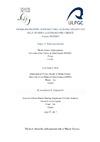Please use this identifier to cite or link to this item:
https://accedacris.ulpgc.es/jspui/handle/10553/74968
| Title: | Seagrass mapping with Sentinel-2A satellite in Gulf of Gera, Lesvos Island, Greece | Authors: | Palomino Gaviria, Ángela Patricia | Director: | García Weil, Luis Francisco Topouzelis, Konstantinos |
UNESCO Clasification: | 241705 Biología marina 250616 Teledetección (Geología) |
Keywords: | Seagrass meadows Posidonia oceanica Remote sensing Accuracy Sentinel-2A, et al |
Issue Date: | 2017 | Abstract: | Seagrass are globally important environments in terms of biodiversity preservation, and for the economic value their ecosystem services provide to human populations. Posidonia oceanica is one of the best studied species in the Mediterranean basin, its presence depends of some factors; They can withstand relatively large variations due to high plasticity such as, variation in temperature and hydrodynamism. On the other hand, Posidonia are sensitive with turbidity, rise of the sea level, salinity. Besides, eutrophication originated by anthropogenic pressure such as, fish farms, and submarine emissaries act on the Gulf and may affect the areas occupied by Posidonia. It is important to create monitoring programs to observe the changes that occur in the region inhabited by Posidonia in the coastal areas, to understand the stability and dynamics of the plant. Remote sensing is a reachable tool that handles the coverage and accuracy requirements needed for working in large scale in order to have control over the ecosystem. It is important to continue and to expand monitoring these areas occupied by this habitat. It is equally important to monitor through field work. In the present study, coastal seagrass habitats in the Gulf of Gera were classified by e- Cognition® software using multispectral high-resolution imaging data recorded with a new sensor on-board of Sentinel-2 satellite, and ArcGIS 10.2® software to obtain the images. An important feature of the remote sensor on board on Sentinel-2A satellite is its multispectral character with bands with different spatial and spectral resolutions. The different methodologies used, and the maps elaborated were an important tool to compare benthic composition, especially for seagrass detection. The accuracy assessment using atmospheric correction and all bands showed a Kappa coefficient of 0.96817, indicating that it was the best process for the detection and classification of the meadows in this case. Moreover, seagrass study using field observations obtained by scuba diving contributes to improve the detection and the classification. The field data contribute to verifying and confirming the satellite images, avoiding remote sensing errors and obtaining better results. | Department: | Departamento de Física | Faculty: | Facultad de Ciencias del Mar | Degree: | Grado en Ciencias del Mar | URI: | https://accedacris.ulpgc.es/handle/10553/74968 |
| Appears in Collections: | Trabajo final de grado Restringido ULPGC |
En el caso de que no encuentre el documento puede ser debido a que el centro o las/os autoras/es no autorizan su publicación. Si tiene verdadero interés en el contenido del mismo, puede dirigirse al director/a o directores/as del trabajo cuyos datos encontrará más arriba.
Show full item recordPage view(s)
179
checked on Oct 31, 2024
Download(s)
94
checked on Oct 31, 2024
Google ScholarTM
Check
Share
Export metadata
Items in accedaCRIS are protected by copyright, with all rights reserved, unless otherwise indicated.
